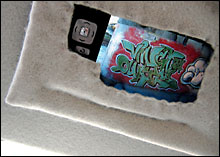"People are moving information around much more quickly now on the Web," says Judith Donath, director of the Massachusetts Institute of Technology Media Lab's Sociable Media Group in Cambridge, Mass. The MySpace generation's tendency to express their opinions, interests, and preferences online, plus its instant access to news and culture blogs, means that what's hip changes rapidly.
"In music, for example, how long a song is a hit is changing very rapidly now," Professor Donath says. When anyone can find out what her friends are listening to and download the latest hit in seconds, music trendsetters have to move fast to stay on the cutting edge.
Donath and her colleagues recently unveiled a new project called " urbanhermes" designed to apply this lightning-fast exchange of information to the fashion world. To these scholars, fashion is just another medium for communicating information, a way to show your place in the social hierarchy. "What you're trying to convey to others is some form of status," Donath says, "but the form of the signal changes. The dress you had to wear in the '90s to be fashionable is very different from what you'd wear today."
At the moment, fashion as a medium for communicating taste cannot change as quickly as electronic media do. You can only wear one outfit a day, and most of us have a finite supply of clothes. Clothing and accessories that can change their "look," however, could make physical fashion as dynamic as Web culture.
The urbanhermes team has demonstrated its concept with a messenger bag that includes a sewn-in electronic display. But the project is not about technology or accessory design. It's about creating a model for how we might integrate technology into our fashion experience.
"Other people are developing the underlying technology," Donath says. "So we're asking, what would I want to do with things that are worn? What would be the social mechanism behind it?"
Imagine subscribing to a daily - hourly! - feed of T-shirt designs. Or admiring a friend's plaid slacks and then turning your own trousers into instant tartan twins. Perhaps clothiers will sell designs without their customers ever having to step inside a store. Maybe advertisers will pay you to wear their brand on your sleeve. These are the sorts of ideas bandied about in Donath's group.
Even though it's still on the drawing board, "e-fashion" has already drawn criticism. "I can't imagine anyone I know wanting to change their jacket from black to red," says Valerie Steele, museum director at the Fashion Institute of Technology in New York City. To her, fashion is "not really a question of an image, but of proportion, volume, the silhouette."
"There's some limited potential" to fabrics with integrated electronics, says Ms. Steele. She sees greater potential in "smart fabrics that respond to temperature so that you are cooler in the sun and warmer in the cold, but they are probably less flashy things than what's being shown at MIT."
Indeed, the most successful examples of integrating technology and fashion are ones in which technology adds to the function, not the appearance, of the clothing. Textronics, an electronic textile manufacturer, for example, made a sports bra that can monitor the wearer's heart rate.
Last week, Apple and Nike unveiled Air Zoom Moire running shoes that, through an integrated wireless sensor, communicate the pace and distance the wearer has to his iPod Nano.
While the technology isn't ready and the fashion industry seems uninterested now, "There's a market for [e-textiles]," says Maggie Orth, CEO of International Fashion Machines (IFM). An ordinary garment that incorporates an electronic display, however, "isn't yet on the horizon."
Projects like urbanhermes explore the possibilities of electronic fashion from a blue-sky academic perspective, while IFM wrestles with the economic difficulties of integrating technology into clothing that will sell for more than the fabrication cost.
It would be particularly difficult to find a market for e-textiles that emit light, as most display technologies currently do. Even if researchers and engineers develop a display technology they can weave into everyday articles of clothing, "from the point of view of fashion, that puts them in a very particular category," explains Ms. Orth. "You aren't going to see something that's lit up on the Oscar runway."
IFM attempted a few years ago to integrate a more subtle display technology into clothing. Orth reasoned that e-ink, a flexible display technology that uses reflected light, would appeal to the fashion industry. Ultimately, however, the project wasn't financially viable. "The profit margins in the fashion industry are super low," Orth explains, and "electronics quantity doesn't match fashion-industry quantity. It's a matter of scale and of proving those business models." Nonetheless, she considers Donath's project an exciting idea.
Whether urbanhermes and e-fashion will convert skeptics and capture trendsetters' imaginations is unclear. Steele thinks it'll be a tough sell - after all, she says, "most people in New York just wear black."
 |
 |
HI-TECH BAG TAG: As a hint of what may come, researchers at MIT's Media Lab came up with this display for a messenger bag that can be altered electronically. |